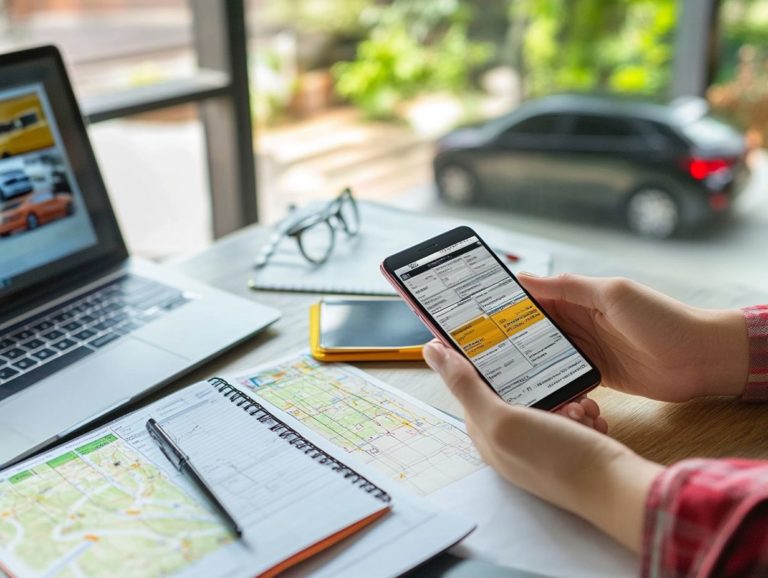How to Trade In Your Old Car Effectively
Considering trading in your old car? It’s not merely a matter of driving it to the dealership; there’s a thoughtful process involved to help you secure the best value.
From evaluating your car s worth and addressing any necessary repairs to deciding between dealership trade-ins and private sales, every step is crucial.
This guide will empower you to maximize your trade-in value, negotiate with confidence, and navigate the paperwork seamlessly, ensuring you feel informed and assured at every stage of the process.
Contents
- Key Takeaways:
- Preparing to Trade In Your Old Car
- Researching Trade-In Options
- Maximizing the Value of Your Trade-In
- Finalizing the Trade-In Process
- Frequently Asked Questions
- What does it mean to trade in your old car?
- How do I know if I should trade in my old car?
- What steps should I take before trading in my old car?
- Do I have to trade in my old car at the same dealership where I’m purchasing a new one?
- Is it possible to negotiate the trade-in value of my old car?
- What are some other options besides trading in my old car?
Key Takeaways:
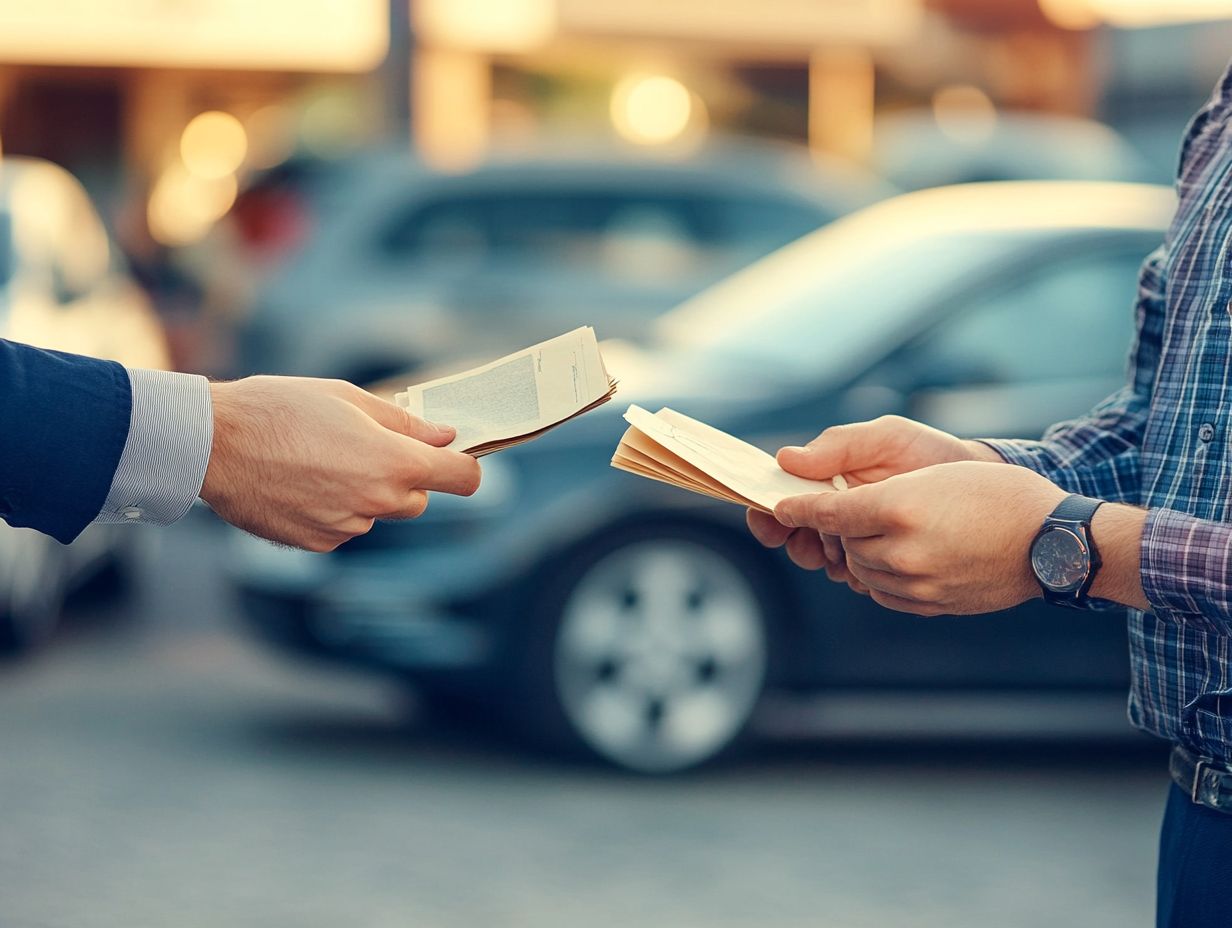
- Unlock the true value of your car by assessing its worth and making necessary repairs before trading it in.
- Research your options and understand negotiations to choose the most beneficial trade-in method.
- Maximize the value of your trade-in by negotiating and timing the process strategically.
Preparing to Trade In Your Old Car
Preparing to trade in your old car involves several essential steps that will make the process easier and help you maximize trade-in value for used cars.
Begin by gathering all necessary documents, including your vehicle registration, car title, and any service records you have. Taking the time to inspect and clean your car will not only enhance its appearance but also increase its appeal and value at the dealership.
Familiarize yourself with online appraisal tools to gain valuable insights into your vehicle’s market value. This knowledge gives you the power to make informed financial decisions during negotiations with potential buyers or dealerships.
Assessing the Value of Your Car
Accurately assessing the value of your car is essential in determining the trade-in value you can expect at dealerships. Leverage resources such as Kelley Blue Book, a trusted car pricing guide, and Black Book Value to obtain a reliable estimate of your vehicle’s worth based on its make, model, and condition.
These tools account for various factors, including mileage, which significantly influences evaluation, along with the overall condition of the vehicle whether it has been meticulously maintained or shows signs of wear and tear. Staying informed about current market trends equips you with insights into how demand for specific models might affect trade-in quotes.
By adopting a well-researched approach, you can effectively negotiate better offers. It s crucial to consider not only these valuation resources but also recent sales and dealership inventory levels to ensure a fair assessment.
Cleaning and Repairing Your Car
Cleaning and repairing your car before a trade-in can significantly enhance its condition and positively influence the trade-in amount you receive. A well-maintained vehicle, both aesthetically and mechanically, becomes far more appealing to dealerships.
When you present a car that shines inside and out, you create a good first impression and convey that you genuinely care for your asset. Minor repairs such as fixing dents or replacing worn-out wipers signal to potential buyers that the car has been treated with respect.
Having maintenance records readily available serves as compelling evidence of your conscientiousness, making it easier for dealerships to justify a higher value during negotiations. This combination of cleanliness and documented care can truly elevate your trade-in experience, maximizing the return you receive.
Researching Trade-In Options
Researching trade-in options is essential for securing the best deal when you re contemplating whether to trade in your car at a dealership or pursue a private sale. Each avenue presents its own distinct advantages, and grasping the intricacies of dealer offers versus private sales gives you the power to make informed financial decisions that align seamlessly with your objectives.
Start your trade-in journey today and discover how easy it can be!
Dealership Trade-Ins vs. Private Sales
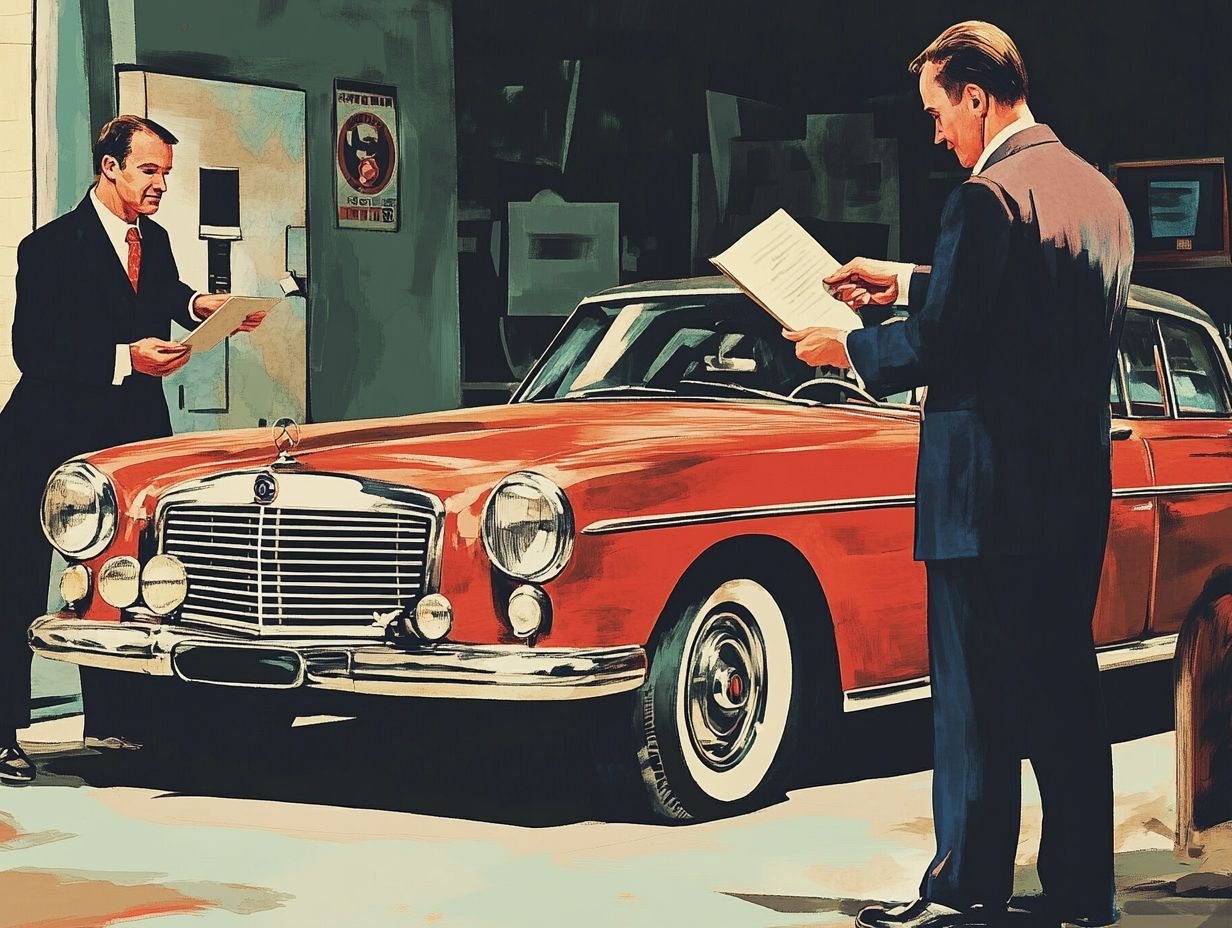
When you’re weighing the options between dealership trade-ins and private sales, it’s crucial to evaluate the benefits and drawbacks of each to see which suits your financial situation and goals. Dealership trade-ins provide a level of convenience and a quicker process.
On the other hand, private sales can potentially net you higher returns if you’re prepared to invest the time in marketing your vehicle.
Each path carries its own unique implications, particularly regarding any outstanding auto loans. For instance, opting for a trade-in allows for an immediate resolution of loan balances. The dealership typically takes care of the payoff during the transaction. This can bring you peace of mind and simplify the transition to your next vehicle.
Conversely, private sales might require you to pay off the loan upfront before you can transfer ownership, complicating the financial landscape considerably. Successfully navigating a private sale often demands more effort in negotiations, advertising, and handling potential buyers.
This can prolong the selling process and impact your financial and time considerations.
Understanding Trade-In Negotiations
Mastering trade-in negotiations helps you secure the best deal possible and ensures you re well-informed about your car s value. By presenting accurate trade-in quotes based on thorough car appraisals, you can strengthen your position and work for a better deal.
Conducting extensive research on your vehicle s market value gives you the power to confidently challenge low offers. When engaging with dealers, it s crucial to maintain a calm demeanor, ready to articulate your expectations clearly.
Keep a close eye on various factors such as your vehicle s condition, mileage, and current market trends.
These can significantly influence the trade-in offer. Building a rapport with the dealer while remaining steadfast in your negotiations can often lead to better outcomes, resulting in a more satisfying and beneficial trade-in experience.
Maximizing the Value of Your Trade-In
Maximizing the value of your trade-in is crucial for securing the highest possible return on your vehicle. This involves strategic preparation and adept negotiation.
By utilizing pricing guides and grasping the intricacies of timing your trade-in, you can boost your chances instantly of achieving positive equity. This means your car s value is higher than what you owe on it, allowing you to secure a more advantageous deal in the end.
Tips for Negotiating the Best Deal
Negotiating the best deal for your trade-in requires a blend of careful planning and effective communication with dealers to secure offers that truly benefit you. By establishing a clear understanding of your vehicle’s worth and exuding confidence during discussions, you empower yourself to negotiate a trade-in amount that aligns perfectly with your financial objectives.
To navigate this process adeptly, it’s essential to remain aware of dealer offers and grasp the factors that influence their pricing strategies.
Engaging assertively in negotiations not only demonstrates your commitment but also positions you as a savvy buyer, which can lead to more favorable terms.
Consider the outstanding loan balance on your current vehicle it can impact your negotiation. Staying informed about recent market trends and being flexible in your strategy will ultimately enhance your trading experience, paving the way for a more advantageous outcome.
Timing Your Trade-In for Maximum Value
Timing your trade-in effectively can have a significant impact on the value you receive. Market trends and the history of your vehicle are crucial factors in the trade-in process. By understanding when demand spikes for specific vehicles, you can strategically plan your trade-in to maximize your positive equity.
Pay attention to seasonal trends. For instance, there’s often a surge in interest during tax refund season when buyers are eager to upgrade. The release schedule of new models can also create a ripple effect in the market; older models often see a dip in value just before the latest ones grace the showroom floor. Regional demands matter too SUVs and trucks may be particularly sought after in areas plagued by harsh weather conditions.
By employing these strategies, you ll have the power to identify those optimal trading windows, securing the best possible return on your investment.
Finalizing the Trade-In Process
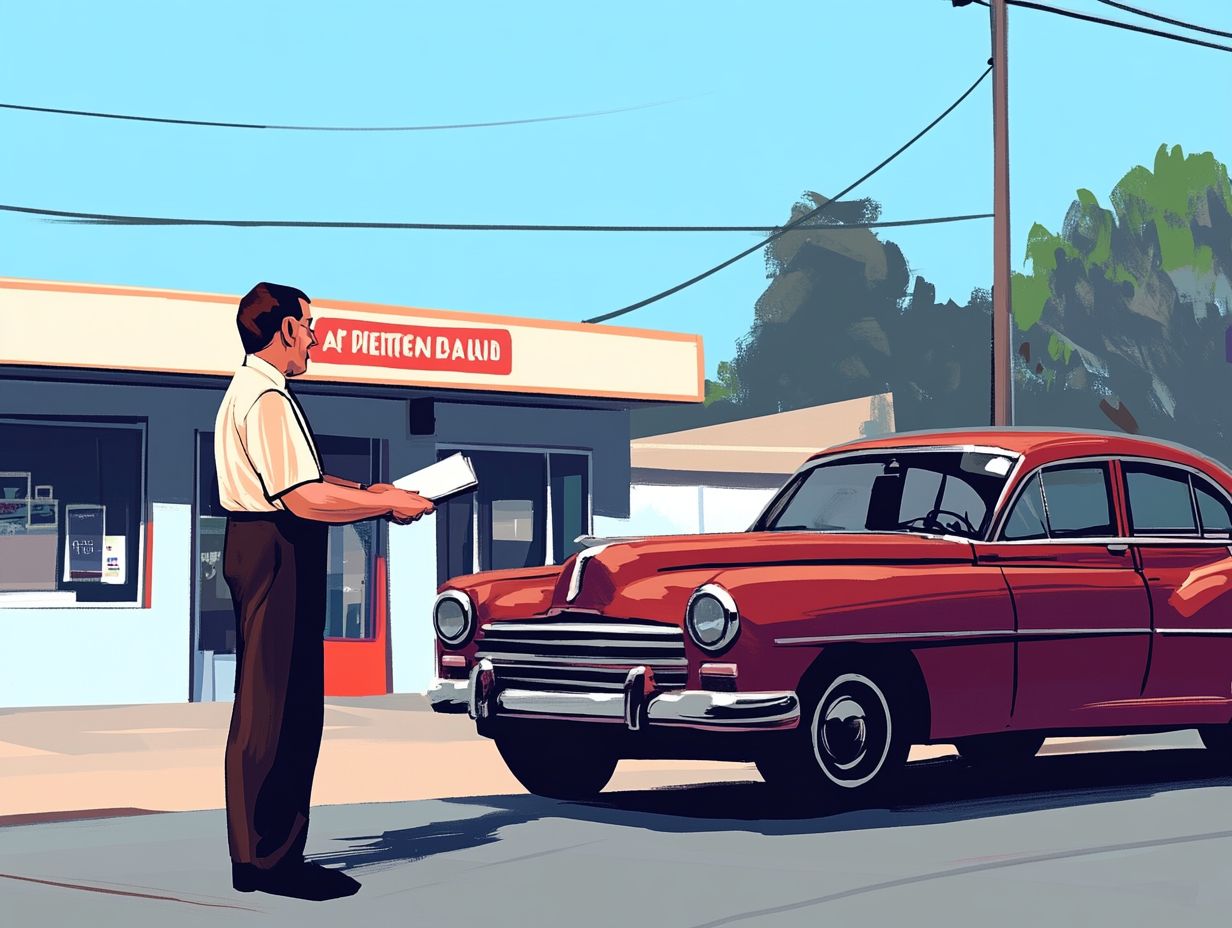
Finalizing the trade-in process represents the pinnacle of your efforts to prepare and enhance the value of your vehicle. It’s essential to ensure that all trade-in paperwork is well-organized and that you fully grasp how to transfer ownership for a seamless transaction.
Take a moment to consider the potential tax advantages linked to your trade-in, as they can further enhance the value of your decision.
Transferring Ownership and Paperwork
Transferring ownership and completing the necessary paperwork is an essential step in the trade-in process that demands your utmost attention to detail. Properly managing the vehicle title and trade-in documentation, along with understanding any financial implications related to your auto lender, will pave the way for a smooth transaction.
Having all the required documents at your fingertips can streamline the entire process, benefiting both you and the buyer. Key paperwork includes:
- Current vehicle title (which must be signed over)
- Bill of sale (a document that proves the transaction)
- Any maintenance records that can attest to the vehicle’s condition
Ensuring that any outstanding loans are settled is crucial to prevent complications down the line.
A common oversight is failing to verify that the title is free of liens a lien is a legal claim against a vehicle due to unpaid loans leading to unnecessary delays. Therefore, review all documentation meticulously and consult with your financial institution to clear up any uncertainties before you finalize the trade-in.
Receiving Payment for Your Trade-In
Receiving payment for your trade-in marks the culmination of the process. Grasping the trade-in amount and its implications on your financial landscape is paramount. It s important to clarify how this payment will influence any loan payoff amounts and to assess the dealership’s overall evaluation to ensure you re getting a fair deal.
Once you’ve settled on the trade-in value, confirm that the amount meets your expectations and aligns with prior agreements. Review the trade-in offer carefully, ensuring it accurately reflects your vehicle’s condition and market value.
If any discrepancies arise, don t hesitate to ask questions. Reflect on how the trade-in payment will interact with any existing loans on your current vehicle. Understanding this relationship can help you sidestep potential financial pitfalls, empowering you to make well-informed decisions as you embark on your new purchase.
Frequently Asked Questions
What does it mean to trade in your old car?
Trading in your old car refers to the process of selling your current vehicle to a dealership in exchange for credit towards the purchase of a new or used car. To ensure you get the best deal, consider these tips for maximizing trade-in value. This can be a convenient and efficient way to upgrade your vehicle without the hassle of selling it yourself.
How do I know if I should trade in my old car?
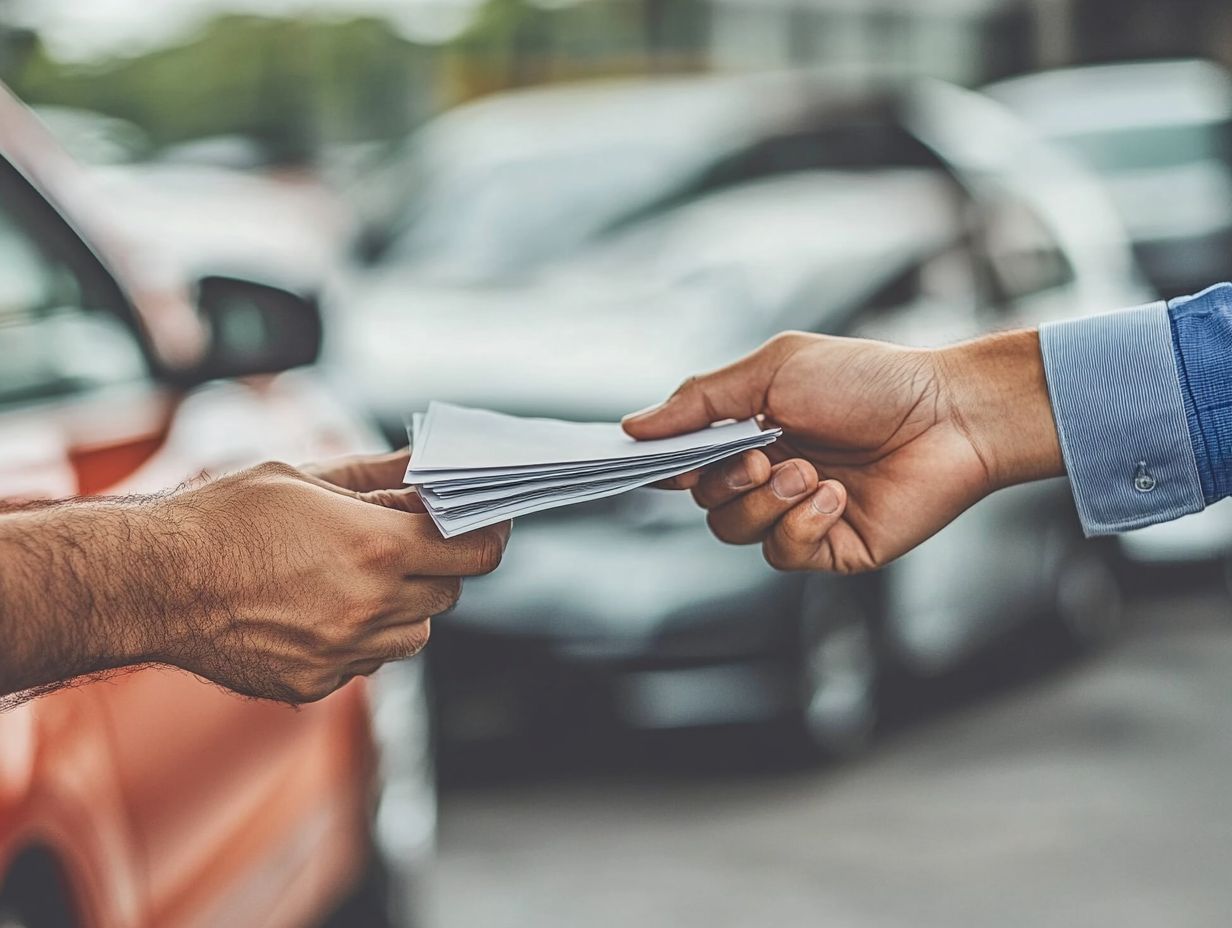
If your car is in good shape but you crave something new, trading it in could be a smart choice! It saves you the hassle of selling it yourself.
However, if your car is in bad shape or has high mileage, you might not get much value.
What steps should I take before trading in my old car?
Research your car’s current market value. This helps set your expectations for the trade-in value.
Clean your car to improve its appeal. Finally, gather all important paperwork like the title and maintenance records.
Do I have to trade in my old car at the same dealership where I’m purchasing a new one?
No, you are not required to trade in your old car at the same dealership where you’re purchasing a new one. You can shop around and get trade-in offers from different dealerships to see which one will give you the best value for your old car.
Is it possible to negotiate the trade-in value of my old car?
Absolutely! You can negotiate the value of your trade-in just like you would when buying a car.
Use the market research you ve done as leverage, and don t hesitate to walk away if the offer doesn t meet your expectations.
What are some other options besides trading in my old car?
If the trade-in value doesn t meet your expectations, consider selling the car yourself, donating it, or using it as a down payment.
Weigh your priorities and potential gains from each option before making your choice!



